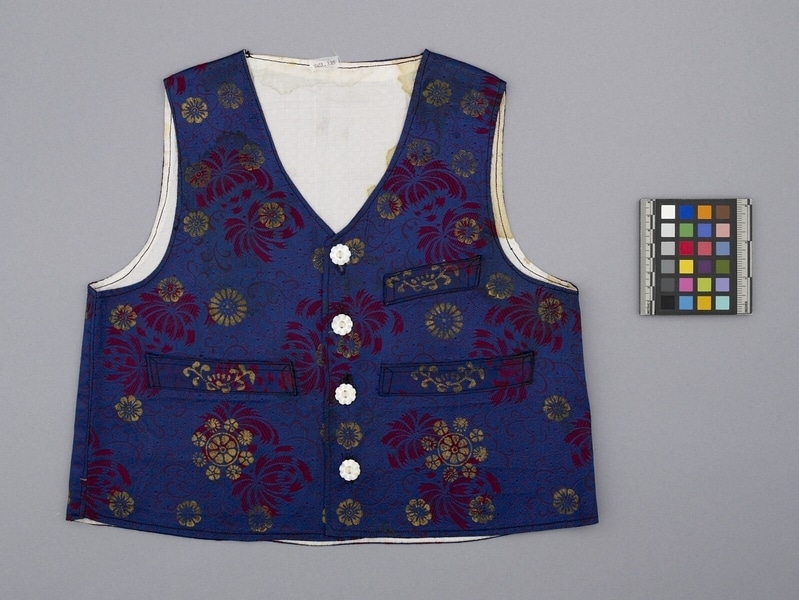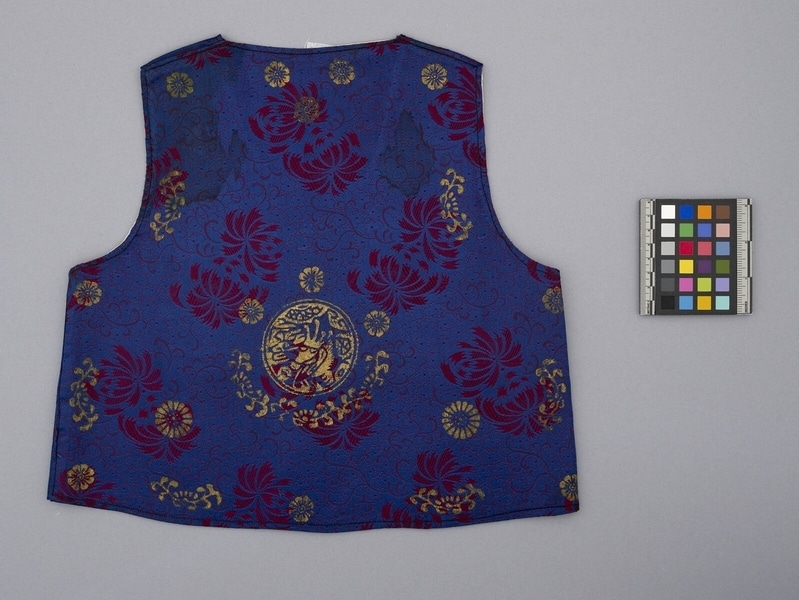Boy's Vest Item Number: Ed1.335 from the MOA: University of British Columbia


Description
Vest fastening in the centre front with five shell buttons shaped like flowers, made of dark blue damask with a fine overall flower pattern and a bolder pattern of flowers, all in reddish pink. Vest is decorated with gold stamped designs shaped like flowers and clusters of flowers. At the centre back there is a roundel surrounded by flowers and enclosing a dragon. On the front there is a pocket with an outside facing at each side, and on the left side above the pocket is a facing with no pocket. The vest is lined with white fabric woven in a pattern of small squares.
History Of Use
Vests in western style began to be widely used in the 1930s, when they became popular. This reflected western influence in Korea after the opening of Korea to the outside world in the late 19th century. Before the 1930s, boys wore longer sleeveless vests called “Bae-ja”, which fastened with a cord at underarm level and tied at the centre front. The pockets and buttons also reflect western influence, the pockets replacing the pouches formerly used to carry small items and the buttons replacing the ribbon ties formerly used. Vests worn by men normally have five buttons, while those worn by boys have four. Gold stamps were used to decorate clothing worn on special occasions, such as holidays or birthdays. Gold stamp work, “Kum-bak”, was done by masters, called “Kum-bak-jang-in” working in markets.
Iconographic Meaning
The fine fabric and gold stamp work indicate that this vest was to be worn on special occasions.
Specific Techniques
The vest is made with machine stitching except for the buttonholes, which are sewn by hand. The gold stamp work was done by painting paste onto a carved wooden stamp and pressing this onto the clothing. The master then pressed gold leaf onto the pasted area and hit it lightly with a small hammer. It was then left to dry for one or two days, after which the excess gold was brushed away.
Narrative
Worn by Mark Elrod as a boy, while living with his family in Korea. Most of the clothing in the J. McRee Elrod Collection was made for him and his family by friends while they were living in Korea, much of it by Kim, Sung Sook. She and her family lived cooperatively in the same house as the Elrod family. While they were there, the Elrods preferred to wear Korean clothing on very cold days and for social occasions. They found it to be more comfortable than western clothing in cold weather, as public buildings were unheated in the period immediately following the Korean War. It also was more comfortable for floor seating in Korean homes, and easier to store with limited furniture than western clothing. The children’s clothing was worn by their children.
Item History
- Made by Sung Sook Kim (Maker) in Seoul, Korea between 1955 and 1960
- Collected between 1955 and 1960
- Owned by Mark Elrod
- Owned by J. McRee Elrod before October 13, 1976
- Received from J. McRee Elrod (Donor) on October 13, 1976
What
Who
- Culture
- Korean
- Creator
- Sung Sook Kim (Maker)
- Previous Owner
- Mark Elrod and J. McRee Elrod
- Received from
- J. McRee Elrod (Donor)
Where
- Holding Institution
- MOA: University of British Columbia
- Made in
- Seoul, Korea
When
- Creation Date
- between 1955 and 1960
- Collection Date
- between 1955 and 1960
- Ownership Date
- before October 13, 1976
- Acquisition Date
- on October 13, 1976
Other
- Item Classes
- textiles
- Condition
- good
- Accession Number
- 0335/0016